The Wildlife Department has long been dedicated to the discovery of what makes our fish and wildlife populations thrive. Sometimes that discovery starts with a search of the state to find where the animals are living, and sometimes the search leads to more questions. As we prepare to enter a new decade of wildlife study, we checked in with the Wildlife Department’s Wildlife Diversity staff for their insights into research and surveys that have wrapped up in the past 10 years.
To Everything a Season
One of the first wildlife projects completed in this decade was also the first of its kind. In 2010, surveyors with the Oklahoma Biological Survey wrapped up the Oklahoma Winter Bird Atlas, the first statewide winter-season bird distribution atlas in the nation! More than 550 2-mile square blocks were surveyed across the state that generated information about 183 wintering bird species.
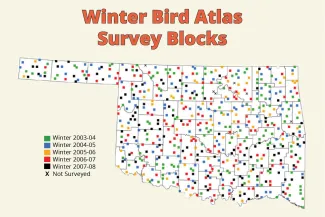
“Most bird atlases are focused on the breeding season, but Oklahoma has a suite of birds that are only found in the state in winter,” said Mark Howery, biologist with the Wildlife Department. “And surveys of some year-round residents like the brown-headed nuthatch were more successful in the winter than in the breeding season.”
It Takes a Team
Surveys take a lot of time; oftentimes weeks or months in the field are needed to apply different survey methods and test various techniques. With our state’s incredible diversity – both of wildlife and habitat types – the Wildlife Department regularly looks to our community of research partners for help. In 2011, a survey team with the University of Oklahoma completed a five-year study of five Wildlife Management Areas – Packsaddle, Atoka, Cookson, Sandy Sanders and Pushmataha WMAs – and documented 99 species of reptiles and amphibians. The survey not only confirmed expected species, but also documented species that had not yet been reported on the area and recorded substantial range extensions for some species.
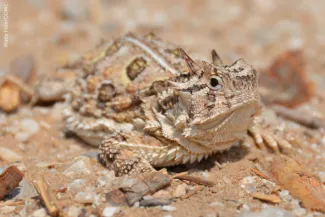
“Many of our state’s reptiles and amphibians are secretive or only active during short windows of time. So it requires a lot of effort at the right time to really understand their distribution or abundance,” said Matt Fullerton, biologist with the Wildlife Department. “Partnering with dedicated survey teams is the only way we can gather this much data about so many species across such a large geographic area.”
This project was funded in part by ODWC’s State Wildlife Grants Program Grant T-35-P-1 and the University of Oklahoma.
Uncovering the Unexpected
A study initially focused on invasive Asian carp in the Kiamichi River didn’t reveal many bighead or silver carp, but did uncover an unexpectedly large population of native blue suckers. In 2013, researchers with Oklahoma State University followed-up on the find with a study of the suckers, a species of greatest conservation need, which answered a lot of questions about the fish’s population and demographics.
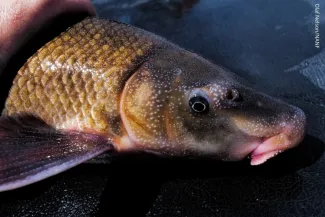
“We were all blown away by the number of fish they documented,” said Curtis Tackett, fisheries biologist with the Wildlife Department. “In addition to shedding light on the different age classes and sex ratio of the fish, researchers also tagged more than 100 blue suckers and tracked their spawn in three Red River tributaries.”
What started out as a fact finding mission for an invasive species turned into a positive breakthrough about a native fish.
This project was funded in part by ODWC’s State Wildlife Grants Program Grant F13AF01214 and Oklahoma State University.
We’ve Only Scratched the Surface
In 2013, the Oklahoma Biological Survey began compiling existing records for three rare dragonflies and then launched a search that effectively doubled the number of records and added dozens of new locations for the species. And while the project shed light on these fierce insects, a mystery remains.
“We’ve never documented the larvae of the Ozark emerald dragonfly in Oklahoma,” said Wildlife Department biologist Matt Fullerton. “So we are following this project with an in-depth look of the life history and ecology of this rare species.”
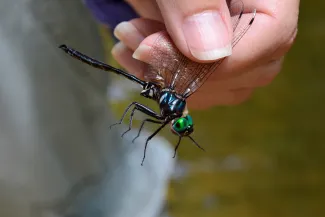
“There are a lot of unknowns in nature – especially in the insect world. Without experienced surveyors taking time to extensively study these species, we may only have just a handful of records to shape our understanding of species’ distribution and abundance.”
This project was funded in part by ODWC’s State Wildlife Grants Program Grant F13AF01188 and the University of Oklahoma.
Traditional Meets Contemporary
Caves and streams are important for many species of salamander, including the grotto salamander and the Oklahoma salamander, our state’s only namesake vertebrate. In 2014, researchers with the University of Tulsa wrapped up a project that tied a traditional survey for the two salamanders with a genetic assessment. The survey team inspected 74 Ozark streams and 26 of the region’s caves and found the target species in a majority of their study sites – and added several new sites for both species. Through the survey the number of sites grotto salamanders are known from grew by 25 percent and the known range of the Oklahoma salamander expanded into six new stream watersheds.
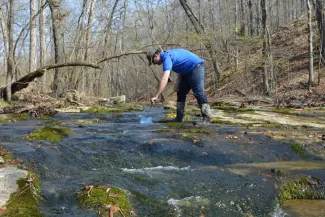
“Expanding the known range of both of these rare species was a fantastic accomplishment,” said Mark Howery, Wildlife Department biologist and grant leader for the survey. “But their genetic data also served as proof that the Oklahoma salamander has alternative life histories; before the study the Oklahoma salamander was thought to be two species, one with a land-dwelling adult and one with an aquatic adult.”
This project was funded in part by ODWC’s State Wildlife Grants Program Grant F11AF00082 and the University of Tulsa.
Habitat is Key
Mussels, or freshwater clams, have been the focus of at least four research or survey projects in the last decade. And while each project presents environmental and personnel challenges – oftentimes a combination of unexpected and unsafe flooding during scheduled sample periods and limited staff that are available, experienced with mussel identification, and scuba certified – these projects have all had a reoccurring and positive outcome.
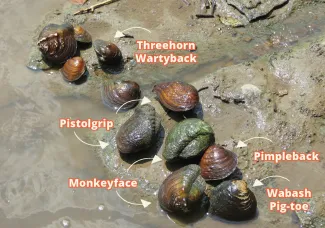
“Oklahoma has a lot of rare and declining mussels and these species need conservation attention,” said Curtis Tackett, Wildlife Department biologist. “But I’m routinely surprised by the number of mussels and the diverse assemblages of mussels you can find – when habitat conditions are right. A lot of the large mussel beds we find have more common species coexisting with our very rare and declining mussels.”
Survey success often hinges on searching in the right locations.
Mussel surveys were funded in part by ODWC’s State Wildlife Grants F10AF00135, F11AF00027, F11AF00030 and F14AF01355, Oklahoma State University and the Oklahoma Biological Survey.
Searching for One Species Can Generate Information about the Whole Community
Even though surveyors with the University of Oklahoma were specifically targeting Texas kangaroo rats, a species that hasn’t reliably been found in Oklahoma since the early 1900s, they helped us better understand the small mammal community of seven southwestern Oklahoma counties. Intensive surveys of more than 250 locations surrounding the rat’s historic records may have been unsuccessful, but 2,178 individuals of 18 other mammal species were found in their traps.
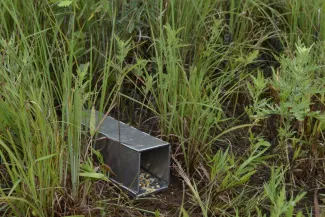
“This project gave us the best evidence to date that the Texas kangaroo rat is likely extirpated from our state,” said Mark Howery, Wildlife Department biologist and survey grant leader. “This project is still a huge success even though the target species wasn’t found. Beyond answering the question of if the species is still in Oklahoma, it helped shape our understanding of the entire small mammal community.”
This project was funded in part by ODWC’s State Wildlife Grants Program Grant F14AF01224 and the University of Oklahoma.
Rare Species Offer a Complex Challenge
In 2017, survey teams from Southwestern Oklahoma State University and the University of Oklahoma set out to learn more about our state’s diverse collection of mayflies and caddisflies, aquatic insects that are a major part of the food chain. Though they did not discover the primary target, the rare three-toothed triaenodes caddisfly, they were able to update our understanding of where many species can be found.
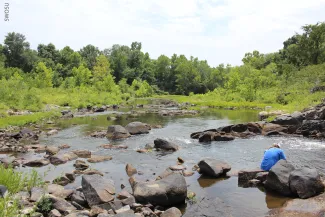
“This project is a great example of how difficult and complex it can be to collect and identify rare aquatic insects,” said Kurt Kuklinski, research supervisor with the Wildlife Department. “The survey teams were dedicated and covered a lot of water in their search, but the small size and rarity of the target insects presented a distinct challenge. Beyond that, these species are incredibly similar to one another and can only be identified by very complex anatomical features, which is a completely different challenge.”
This project was funded in part by ODWC’s State Wildlife Grants Program Grant F16AF01215, SWOSU and OU.